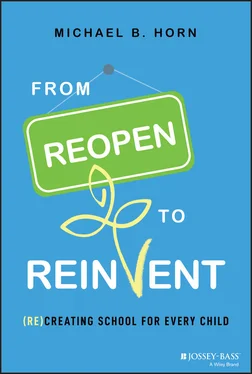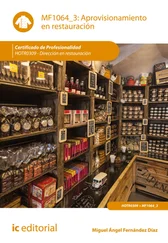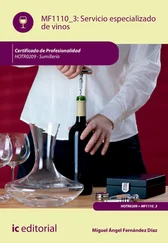Michael B. Horn - From Reopen to Reinvent
Здесь есть возможность читать онлайн «Michael B. Horn - From Reopen to Reinvent» — ознакомительный отрывок электронной книги совершенно бесплатно, а после прочтения отрывка купить полную версию. В некоторых случаях можно слушать аудио, скачать через торрент в формате fb2 и присутствует краткое содержание. Жанр: unrecognised, на английском языке. Описание произведения, (предисловие) а так же отзывы посетителей доступны на портале библиотеки ЛибКат.
- Название:From Reopen to Reinvent
- Автор:
- Жанр:
- Год:неизвестен
- ISBN:нет данных
- Рейтинг книги:4 / 5. Голосов: 1
-
Избранное:Добавить в избранное
- Отзывы:
-
Ваша оценка:
- 80
- 1
- 2
- 3
- 4
- 5
From Reopen to Reinvent: краткое содержание, описание и аннотация
Предлагаем к чтению аннотацию, описание, краткое содержание или предисловие (зависит от того, что написал сам автор книги «From Reopen to Reinvent»). Если вы не нашли необходимую информацию о книге — напишите в комментариях, мы постараемся отыскать её.
From Reopen to Reinvent,
From Reopen to Reinvent
From Reopen to Reinvent
From Reopen to Reinvent — читать онлайн ознакомительный отрывок
Ниже представлен текст книги, разбитый по страницам. Система сохранения места последней прочитанной страницы, позволяет с удобством читать онлайн бесплатно книгу «From Reopen to Reinvent», без необходимости каждый раз заново искать на чём Вы остановились. Поставьте закладку, и сможете в любой момент перейти на страницу, на которой закончили чтение.
Интервал:
Закладка:
Mrs. Owens glared at her. Mr. Owens' mouth hung open. They both folded their arms. Then Mrs. Owens broke the silence .
“I have no idea how these things are our problems. But I do know that Julia seems really interested in robotics these days. Maybe she could do that during recess?”
“Or you could at least get the basics right so she doesn't fall so far behind the kids in the other schools,” Mr. Owens said. “She's just gotta keep up or else it'll come back to bite her in middle school.”
Julia's parents kept throwing a torrent of ideas and conflicting thoughts at Ball. It was hard to make sense of them all, but it did prompt a question in her mind: What were Ball's hopes and dreams for the children at Spruce Peak? Did her teachers agree? What about the parents? Heck, did she even agree with herself? It seemed the Owens weren't on the same page as each other .
* * *
What's the purpose of schooling?
Even though it may seem like a straightforward question, once you scratch the surface, it's anything but. There are countless views on the topic.
Lists of things schools should do—or have historically done, for better or worse—grow long. Things like convey knowledge; ensure learning; sort students; build citizens; prepare learners for employment; focus on skills; teach children to interact with others and socialize; educate the whole child; help students become independent thinkers; and many more.
Clarifying priorities is challenging. Making trade-offs is tough.
Different communities and pockets of parents hold different opinions, points of emphasis, and priorities based on their specific circumstances. 1 Chapter 7explores what parents want from schools, but, suffice to say, parents don't always agree with what educators think—nor do educators always agree with each other. Policymakers have their own sets of views that often clash.
Many schools struggle because there is a lack of coherence amid competing priorities. Chapter 11offers a framework to help leaders understand which tools will help them when there isn't agreement on the goals of a school, which is a common occurrence and thus a critical topic.
But schools also often suffer because there is a lack of clarity about what they are trying to accomplish. There are unspoken assumptions about what schools are trying to do. Unstated goals lie embedded implicitly in policies, regulations, structures, and practices formed long ago.
Addressing the purpose of school in each community is critical.
A BRIEF HISTORY OF THE PURPOSE OF SCHOOLING
The primary policy rationale for public schools' purpose has changed over time. 2 In Disrupting Class , Clayton Christensen, Curtis Johnson, and I offered an overview of these shifts. 3 Here's a brief summary.
Through much of the 1800s, a kind reading of history would say that the central role of public schools was to preserve the American democracy and inculcate democratic values. 4
In the 1890s and early 1900s, competition with a fast-rising industrial Germany constituted a mini-crisis. The country shifted by creating a new role for public schools: to prepare everyone for vocations. That meant providing something for everyone, with a flourishing of tracks and courses and increased enrollment in high school, which in 1905 just one-third of children who enrolled in first grade ever attended.
Another purpose was added to America's schools in the late 1970s and early 1980s: keeping the country competitive. Although this one had echoes of the prior purpose, it was different, as the nation became consumed by how students were doing in school as measured through average test scores. The vast choices that students had in a “cafeteria style curriculum,” the landmark report “A Nation at Risk” noted, was one “in which the appetizers and desserts can easily be mistaken for the main courses.” 5 Having something for everyone, in other words, was no longer a virtue. It was a vice.
Just 20 years later, the primary purpose shifted again. This time society asked schools to eliminate poverty by not just focusing on schools' average test scores, but instead to make sure that children in every demographic reached a basic measure of proficiency in core subjects. The theory of action was that academic achievement unlocked opportunity.
As that consensus has eroded in recent years, there has been some drift in the primary purpose of schooling from a political perspective. Given that erosion, clarifying an individual school's purpose is perhaps now an even more vital conversation to have to build a coherent school model.
THE IMPORTANCE OF BEGINNING WITH THE END
Without clarity around purpose, educators are often caught in what famed author Stephen Covey called “the activity trap”—working harder at the things schools do just because they are the things they do, not because they are the most important things.
In one of the best-selling nonfiction books of all time, The 7 Habits of Highly Effective People, Covey wrote how beginning with the end in mind is critical. Without a clear understanding of your destination, you won't know if the steps you're taking are headed in the right direction. “People often find themselves achieving victories that are empty, successes that have come at the expense of things they suddenly realize were far more valuable,” Covey said.
Covey's basic argument is that “all things are created twice.” The first step is to create something in the mind. Then there's the physical act of creating something to make it real. If you haven't thought through what you want a school to do up-front, then it's easy to let past habits and inertia shape what schools accomplish by default.
If famed leadership and management scholars Peter Drucker and Warren Bennis are correct that “management is doing things right; leadership is doing the right things,” then management is all about executing, but leadership is about clarifying purpose and priorities, Covey argued in his book. To be clear, this can and should be an iterative and emergent process based on putting something into action, learning, and adjusting course. We talk a bit more about that in Chapter 10. But not deliberating about the end reduces educators to “straightening deck chairs on the Titanic ,” but not ensuring that the ship isn't simply headed down. 6
As Grant Wiggins and Jay McTighe wrote in the context of education in Understanding by Design , 7 good teachers start with the goals and how they would know if students have met them. They then backward map all the things they need to provide to get to those outcomes. The same is true for good schools.
AN OPPORTUNITY TO CLARIFY PURPOSE
In line with the previous chapter, the pandemic isn't just a threat. It has created an opportunity to have a conversation within individual communities to clarify the purpose of schooling. Many communities are ready for and having this conversation.
Starting in March of 2020, phrases that were considered educational jargon became mainstream in the public conversation about schools. Things like remote learning, virtual learning, online learning, learning loss, hybrid learning, asynchronous and synchronous learning, microschools, and learning pods, as well as questions around what gets taught—like Critical Race Theory—entered the popular verbiage (see Figure 2.1).
Many of the educators with whom I speak aren't thrilled that many of these phrases have become central. They wish we were having conversations about things like social-emotional learning, active learning, mastery-based learning, habits of success, personalizing learning, relationships, agency, skills, supporting the whole child, knowledge, character, lifelong learning, civics, and more.
Читать дальшеИнтервал:
Закладка:
Похожие книги на «From Reopen to Reinvent»
Представляем Вашему вниманию похожие книги на «From Reopen to Reinvent» списком для выбора. Мы отобрали схожую по названию и смыслу литературу в надежде предоставить читателям больше вариантов отыскать новые, интересные, ещё непрочитанные произведения.
Обсуждение, отзывы о книге «From Reopen to Reinvent» и просто собственные мнения читателей. Оставьте ваши комментарии, напишите, что Вы думаете о произведении, его смысле или главных героях. Укажите что конкретно понравилось, а что нет, и почему Вы так считаете.












